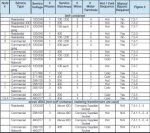PVfarmer
Senior Member
- Location
- Newport County, Rhode Island, USA
Forget the PV for a moment, there is no such transformer that will take 120/240 single phase in and output 480/277 three phase, there are phase converters, VFD's or other units that use a combination of other basic components that can do this - but none of them can be "reverse fed" to convert three phase to single phase.
I hear you -forget the PV, except for one thing...
zman keeps asking about 1000V DC systems- so that means there is no doubt he's trying to use the 480/277V wye SE inverters.
So he'd be using the transformer he says he ordered (if he ordered the one he posted a slip for way back in post # 7 or 8) to convert the 480/277 wye inverters (which are necessary for 1000V DC) *down* to 120/240 1ph.
However, it seemed the xfmr in his pic was 480 delta!
Forgetting PV, if you had a 480/277V wye source of power (N included), you would *not* get a 480V delta transformer, no matter what phase or voltage the other side of it was, step up or down.
Back to PV, the neutral is required by the 480/277V PV inverters for voltage reference- where's the N going to go if you've got a 480V delta xfmr? Into the ground?
That sounds like a pretty poor place for a voltage reference! :huh:
kwired- Can you answer this?
Seems like 480V primary xfmrs are quite common, however 480/277 *wye* primary xfmrs aren't standard at all.
480/277 wye *secondary* xfmrs are the common ones. They all say "reverse connectable".
If you wanted to supply loads from a 480/277V wye source, are there any obvious contrasts between using:
a bank of three single phase 277V to 120V xfmrs, wired in wye on both sides, so you've got 208/120V wye for loads.
vs.
a single 208/120V pri / 480/277 secondary (both wye of course) xfmr "reverse connected".
Not asking about price or available space here. For instance, 45kVA of xfmr(s), so a bank of three 1ph 15kVA 277V -> 120V vs. a single 3ph 45kVA 208/120V -> 480/277V in reverse.
I can't seem to come up with any difference beyond a few hundred $$ or less.
Anyhoo, this is how I see the current situation in this thread.
zman appears to have a 480V delta to 120/240V 1ph xfmr on the way.
He wants to use SE inverters, either 1ph or 3ph, not suite sure, but he wants to install 66kW or more of AC PV output.
He only has a 50kVA (or maybe even 25kVA) 120/240V service xfmr!
STOP RIGHT THERE!!
There's no way you can go ahead and install 66+kW of PV without talking to your POCO first. Do that, zman.
Beyond that, there are 480V delta output inverters made- pretty sure Fronius and KACO for two. These don't have an N output circuit, and are 480V L-L.
I'd assume they make those inverters because...wait for it...
people still have 480V delta services.
Unfortunately, zman, you don't.
The only way that I can comprehend the 75kVA 480V delta -> 120/240V xfmr you ordered working for you is if you had 480V delta service, and wanted to supply 7500w of 120/240V loads (10% of the 75kVA and limited to 3250w on each line of 120V) from a breaker off of a main 480V delta panel to that new xfmr.
If you are going to go with 1 ph SE 120/240V inverters, you...wait for it...
don't need to buy an xfmr at all! Cancel the order! Why would you step it up to 480V when 480V isn't involved anywhere in the system? :huh:
At least I wouldn't think the POCO would charge you for changing a 50kVA to a 75kVA service can.
Please, if there's something else zman's new xfmr is intended for besides a 480V delta source or power (or reverse fed by 120/240V for some totally weird reason), somebody let me know?



